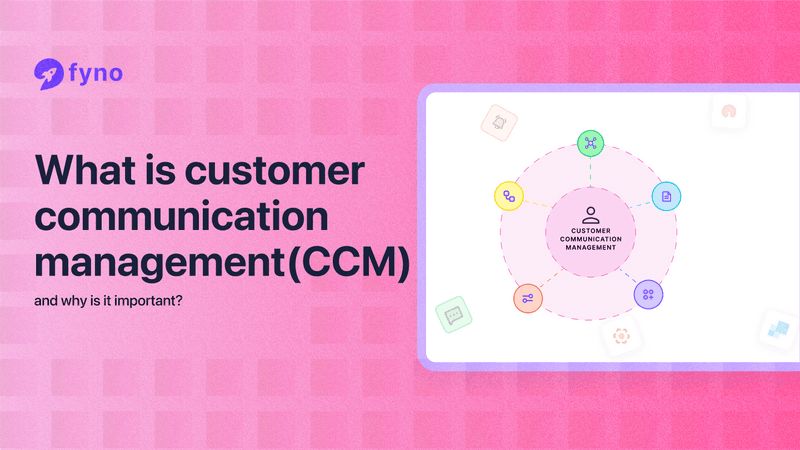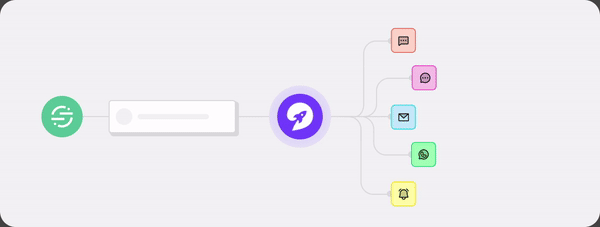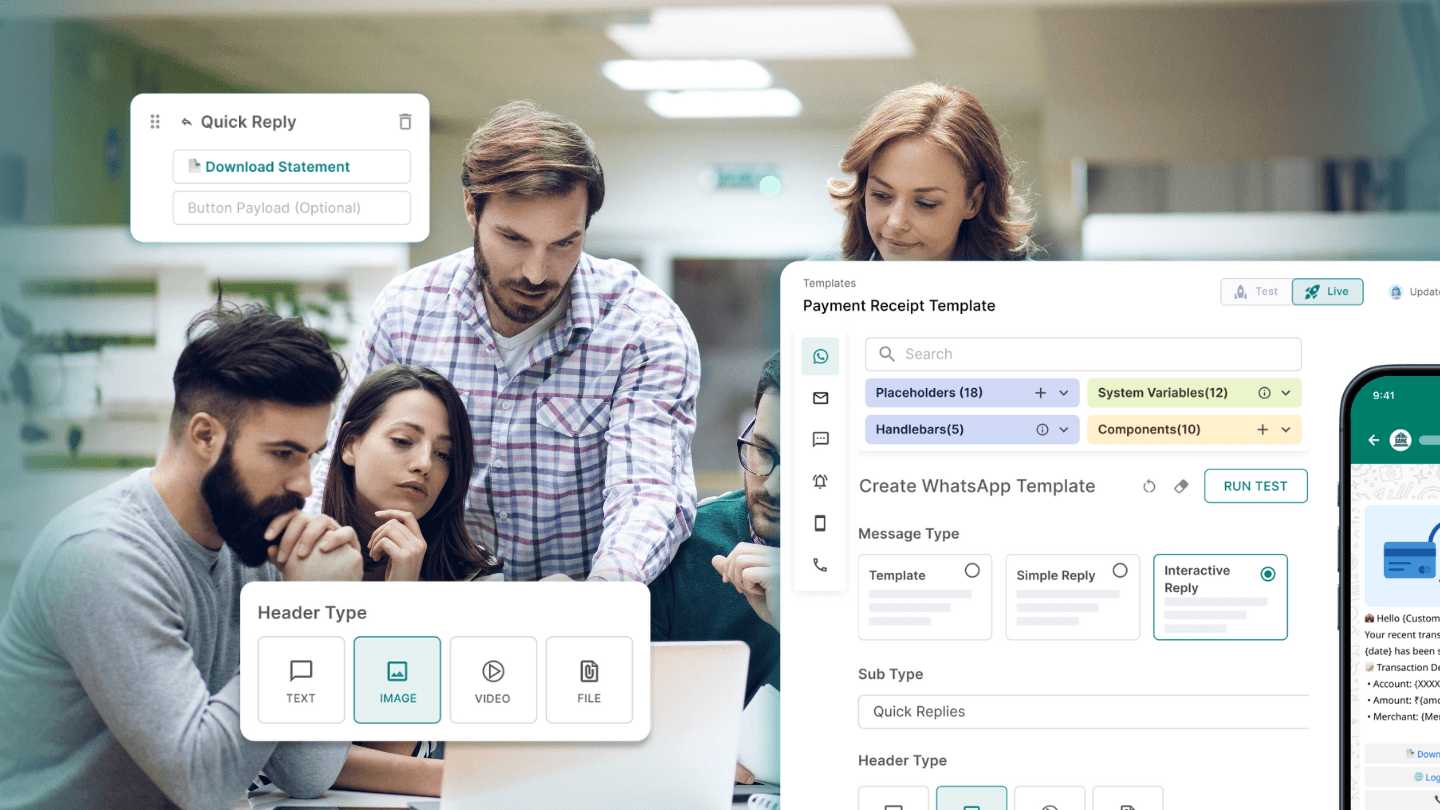What is customer communication?
Customer communication refers to how businesses interact with their customers to provide information, support, and foster relationships. This communication can occur through multiple channels, including email, social media, phone calls, live chat, and in-person interactions.
Effective customer communication is essential for building strong relationships, ensuring customer satisfaction, and promoting brand loyalty.

What is customer communication management (CCM)?
Customer Communication Management (CCM) is a strategic approach that enables businesses to streamline and optimize their communications with customers across multiple channels. It leverages technology to design, deliver, store, and retrieve customer communications consistently and efficiently. CCM aims to enhance the customer experience by ensuring personalized, timely, and contextual interactions between a brand and its customers.
Channels of communication in customer communication management
CCM solutions leverage multiple communication channels to reach customers. These include:
- Email: For newsletters, promotions, transactional updates, and service notifications.
- SMS: For time-sensitive alerts, reminders, and two-factor authentication.
- Social Media: For real-time engagement, customer support, and brand promotion.
- Chatbots: For instant, round-the-clock customer support and conversational experiences.
- Voice Calls: For personalized service, support, and consultations.
- Web Portals: For self-service options, account management, and knowledge bases.
The benefits of implementing customer communication management
- Improved Customer Experience: Delivering a consistent brand voice across all communication channels fosters trust and credibility.
- Operational Efficiency: Designing a communication strategy streamlines existing support processes and automates manual, error-prone, and redundant tasks. This leads to an increase in productivity and cost savings.
- Enhanced Data Utilization: Businesses can personalise communication by utilizing customer data and preferences, making customers feel valued and understood.
- Increased Engagement: Consistent and relevant communication fosters stronger customer relationships, encouraging repeat business and positive word-of-mouth.
- Scalability: CCM solutions can adapt to growing customer bases and evolving communication needs, ensuring businesses can scale their operations seamlessly.
- Regulatory Compliance: Centralized management of customer communications helps businesses adhere to industry standards, regulations, and data privacy laws, mitigating legal risks.
Challenges in implementing customer communication management
While the benefits of CCM are significant, businesses may face the following challenges during implementation:
- Integrating with a growing list of apps: Ensuring seamless integration of various communication channels, data sources, and existing systems can be complex and resource-intensive.
- Customer Data Management: Handling large volumes of customer data safely and effectively is crucial for personalized communication and compliance.
- Meeting customer preferences: Use advanced data analysis and segmentation capabilities to create truly personalized experiences for each customer based on their communication preferences.
- Rapid Scalability: Adapting the CCM solution to handle a rapidly growing customer base and evolving communication preferences can be challenging without a robust and flexible platform.
Examples of exceptional customer communication
Here are a few examples of exceptional customer communication:
- Amazon: Utilizes personalized emails, recommendations, and notifications based on purchase history, browsing behaviour, and preferences, fostering a tailored shopping experience.
- Zappos: Renowned for its exceptional customer service and proactive communication, consistently going above and beyond to address customer needs and concerns.
- Netflix: Provides tailored content suggestions, updates, and personalized recommendations based on viewing habits and preferences, enhancing user engagement and satisfaction.
5 best strategies for effective customer communication management
Customer communication management is crucial for building strong relationships and enhancing customer satisfaction. Here are five top strategies to streamline your communication efforts and ensure consistent, positive interactions with your clients.
Centralised communication management
Smart automation
Data-driven insights
Switch to an opti-channel approach
Continuous feedback.
Let's dive into them one by one.
Centralized Communication Management: Implementing an all-in-one communication platform like Fyno can help effectively manage all customer communications from a single location, which will ensure consistency, efficiency, and cost savings.
Smart automation: Setting up smart systems to automate message routing based on customer preferences, system failure, and the importance of the message will solve most of the challenges faced by customer communication teams today.
Data-Driven Insights: Leverage customer data, analytics, and feedback to tailor communications, improve targeting, and refine strategies continuously.
Switch to an Opti-Channel Approach: Instead of taking an omnichannel approach, choose an opti-channel approach that focuses on delivering the right message through the right channel at the right time for each individual customer.
Continuous Feedback: Collect and act on customer feedback to continuously improve communication strategies, identify pain points, and enhance the overall customer experience.
5 best practices for optimizing customer communication management
Efficient customer communication management is essential for building strong relationships and improving overall satisfaction. Discover these five best practices to streamline communication processes and enhance customer engagement.
Leverage unified communication platforms
Prioritise data quality and hygiene
Embrace opti channel messaging
Personalise at scale
Continuously optimise with analytics
Let's go through each element individually to see how they contribute to the whole.
Leverage Unified Communication Platforms: Implement a unified platform like Fyno that integrates multiple communication channels, enabling consistent messaging, centralized data management, and streamlined processes. This eliminates silos and ensures a seamless customer experience across touchpoints.

Prioritize Data Quality and Hygiene: Ensure customer data is accurate, up-to-date, and consistently formatted across systems. Implement data validation, deduplication, and regular cleansing processes to maintain data integrity and enable effective personalization and targeting.
Embrace Opti-channel Messaging: Adopt an opti-channel approach that allows you to deliver the right message through the right channel at the right time for each individual customer.

Personalize at Scale: Leverage advanced segmentation, dynamic content, and personalization techniques to deliver tailored messages at scale. Utilize customer data, behaviour, and preferences to create relevant, contextual, and engaging communications that resonate with individual customers.
Continuously Optimize with Analytics: Implement robust analytics and reporting capabilities to track the performance of customer communications across channels. Monitor key metrics such as open rates, click-through rates, conversion rates, and customer feedback to identify areas for improvement and continuously optimize strategies.

By following these best practices, businesses can maximize the effectiveness of their customer communication management initiatives, delivering exceptional experiences that drive customer satisfaction, loyalty, and, ultimately, business growth.
FAQ
1. What is Customer Communication?
Customer communication refers to the various ways businesses interact with their customers to provide information, support, and foster relationships.
2. What is Customer Communication Management (CCM)?
Customer Communication Management (CCM) is a strategic approach to streamlining and optimizing customer communications across multiple channels.
3. What channels are commonly used in CCM?
Common channels used in CCM include email, SMS, social media, chatbots, voice calls, and web portals.
4. What are the benefits of implementing CCM?
The benefits of CCM include improved customer experience, operational efficiency, enhanced data utilization, increased engagement, scalability, and regulatory compliance.
5. What challenges might businesses face when implementing CCM?
Challenges include integrating various communication channels, managing large volumes of customer data, meeting customer preferences, and ensuring rapid scalability.
6. Can you give examples of exceptional customer communication?
Examples include Amazon's personalized emails and recommendations, Zappos' proactive customer service, and Netflix's tailored content suggestions.
7. What is an opti-channel approach in customer communication?
An opti-channel approach focuses on delivering the right message through the right channel at the right time for each individual customer.


